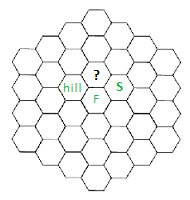Random terrain for AAIE "The World" maps.

I started working on another section of AAIE a couple of months ago. This is part of it
Hex Gids:
Let's say my map starts at the very center of the grid over here →
That center hex is where the party of player characters is hanging out right now.
The hex is covered in a thin deciduous forest. (marked with a green F)
If I go one hex to the left, that hex is rolling hills. (It says Hill in green letters)
If I go to the right that adjacent hex is mostly swamp. (Marked with a green S)
That's all established:
The hex marked with a question mark is the problem. If the players explore that hex It's terrain should take into account the terrain off all the hexes surrounding it.
If I have a chart saying "roll a new terrain based on the hex the party is leaving." Only the Forest hex would be taken into account. that's not a bad solution but not necessarily a very complete one.
Keeping in mind, I'm not generating a hex field, or a large area. I'm generating hexes as needed, when one area has been explored by the group they move on to the next. In real life terms that could take months, depending on how often a group plays and what the GM drops into the current hex. If this were a game of D&D or a similar RPG this system would be nearly useless. The GM would need to know more about the inter-workings of each hex and their relationships with their surroundings. For AAIE is is perfectly acceptable to establish those things through playing the game. The contents of the next hex is supposed to be a surprise to everyone at the table. It doesn't have to make initial "sense" the way traditional fantasy RPG world building would dictate.
My head is saying give each type of terrain a numerical flag, As in Forest is 1, Hills 2, and swamp 3.
when moving to generate and explore a new hex the GM could look at the numerical flags from the surrounding hexes, run them together clockwise to create a code of sorts.
Each combo of flags would have a corresponding chart.
Using our Map above as an example, the code from the (?) hex would be 3,2,1, or swamp forest hills. The Gm would roll on the 3,2,1 chart.
At first glance it would seem that there would have to involve a very large number of charts, however the order of the numbers don't matter. Chart 3,2,1, represents the same information as 2,1,3 or 1,2,3.
Where things get tricky is when a hex is surrounded by other explored hexes creating a situation where the "code" could be up to 6 digits long. This makes me believe I need some function for counting only the three most predominant types of adjoining hex. For example if a hex has six explored neighbors and four of them are forest, one is a swamp, and that last adjoining hex is hills. The "forest" hexes should have a higher influence on the resulting new hex.
As I eluded to earlier I have a working system where the GM roll up the next hex based on the hex the party is leaving. Each of the 12 terrain types has a small 1D10 based chart that determines what terrain type the party is journeying into.
Here is the entry for "forest"
Forest,1-5 more forests6-9 hills10 Swamp
Here is he entry for Hills:
Hills,1: roll 1d4: 1-2 bog 3-4 swamp2-5 More Hills6-7 Open Lands8-9 Forest10 Foot hills
My thought is to keep that set of twelve charts (I'll have to rewrite them slightly) and modify the rolls using simple rules based on the surrounding known hexes.
For example:
If most of the surrounding hexes is the same as the hex the party is currently leaving subtract -1 from the roll.
If most of the surrounding hexes are different types then the hex the party is leaving add +1 to the roll.
That might come a crossed as a cop out (You should be writing discrete 1716 tables damn it!) However, I'm not sure it is a cop out.
This is very simple, takes the surroundings into account, uses what I already have, and weighs the terrain towards expanses of similar terrain.
Those are my basic thoughts on terrain and terrain types, but I still have a long way to go before it's all up and working. Still I generated a few hexes and the contents of them a few days ago and the results were interesting. More importantly the results were game-able. I need to dial up the AAIE strangeness a bit. As with the rest of the game I'll focus on getting the frame work solid then start hanging the weirdness on that.
-thanks for reading .
-Mark.


Comments
Post a Comment